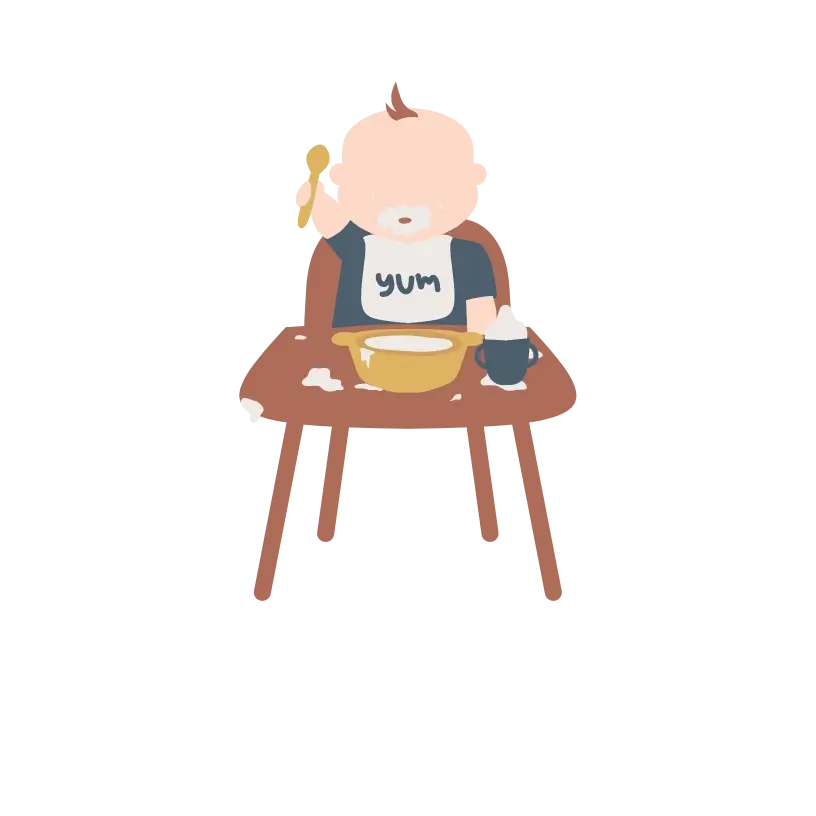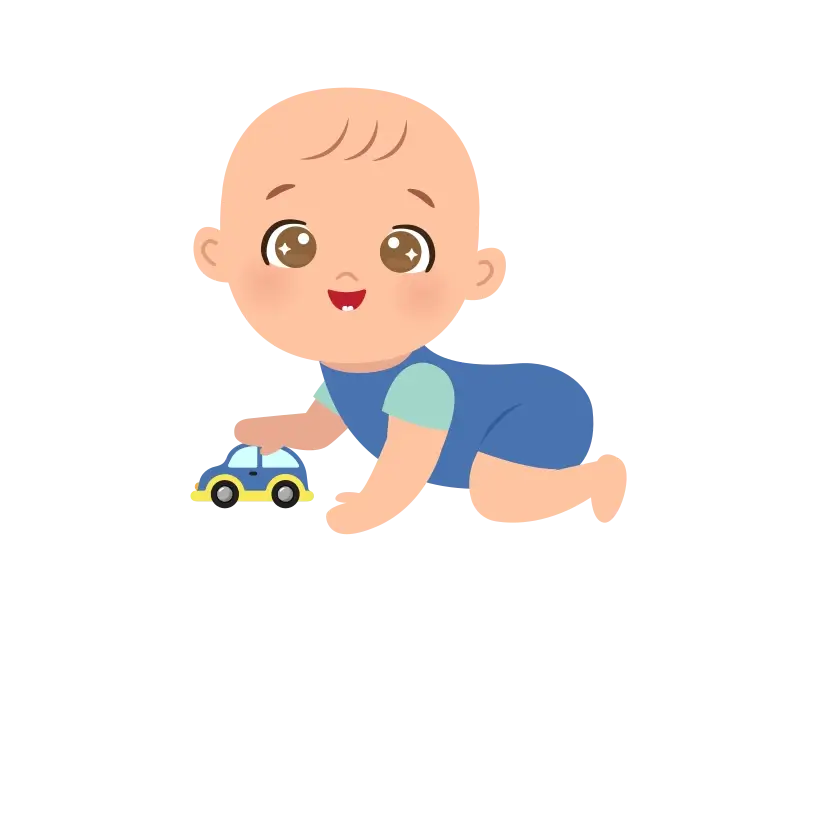Menu

Life with a 17-month-old is like embarking on a thrilling adventure every day. They’re constantly exploring, learning, and expressing themselves, keeping you on your toes. Amidst the chaos, there are heartwarming moments of connection and pride in their achievements.
Their growing language skills and endless curiosity make each day both exhausting and rewarding. It’s a journey of growth, discovery, and unconditional love as you navigate parenthood together.
At 17 months old, your little one becomes more mobile and confident in their movements. They’re likely walking steadily now and can pick up objects from the floor without losing balance, showing improved coordination and strength.
Additionally, they may be able to sit on and move around with ride-on toys, indicating further development in their balance and coordination skills. These milestones highlight the significant progress your child is making in their physical abilities, allowing them to explore and interact with their environment in new ways.
At 17 months old, your little girl might weigh between 17 to 29 pounds and measure around 29 to 33 inches in length. For boys of the same age, their weight can range from 19 to 29½ pounds, and they may measure between 30 to 33½ inches tall.
These numbers can vary, but they give you a general idea of what to expect regarding your child’s growth and development at this stage. Remembering that every child is unique and may grow at their own pace is essential. If you have concerns about your child’s growth, it’s always a good idea to consult their pediatrician.
At 17 months old, self-feeding and independence become significant milestones for your toddler. While it’s true that mealtime can often result in a messy cleanup, it’s essential to recognise the developmental benefits of allowing your child to feed themselves.
Additionally, mealtime provides valuable opportunities for sensory exploration and learning. Letting your child touch, smell, and taste different foods exposes them to new flavours and textures, stimulating their cognitive development.
Now that your baby is 17 months old, aim for three meals a day and consider adding two healthy snacks. Choose nutritious options like fruits, vegetable sticks, toast, bread, or plain yoghurt.
Avoid adding salt or sugar to their food or cooking water. Salt isn’t good for their kidneys, and too much sugar can lead to tooth decay.
Don’t force your toddler to eat: Pressuring your child to eat a particular food can create resistance and negative associations with mealtime. It’s important to respect their appetite and preferences to foster a healthy relationship with food.
Introduce menu options to your toddler: Providing your child with a few healthy food choices empowers them to make decisions and encourages independence. If they’re not interested in eating right away, you can save the meal for later when they’re hungry, promoting a more relaxed approach to mealtimes.
Have family meals: Eating together without distractions allows for quality bonding time and sets a positive example for your child. Offering familiar and favourite foods alongside new dishes encourages them to explore new flavours in a supportive environment.
Keep introducing new foods: It often takes multiple attempts for a child to accept a new food, so persistence is key. Continuously exposing your child to different foods increases their familiarity and may eventually lead to acceptance. Small adjustments, like adding cheese to vegetables, can make unfamiliar foods more appealing.
Make cooking and serving food enjoyable: Involving your child in meal preparation teaches valuable life skills and makes them more invested in the eating process. Get creative with presentations to make meals visually appealing and fun, encouraging your child to try new foods enthusiastically.
Don’t worry if your toddler isn’t eating: If your 17-month-old isn’t eating much, don’t worry. It’s common for toddlers to be picky eaters at this age. Just keep offering a variety of tasty foods, and they’ll likely eat when they’re hungry. If you’re worried about your child’s eating habits, discussing it with your child’s pediatrician is a good idea.
At 17 months old, your child still needs about 11 to 14 hours of sleep daily. They might be transitioning to just one nap, which could change your daily routine. Usually, the morning nap starts to fade away, and either the afternoon nap gets longer or bedtime moves a bit earlier. Fortunately, this transition usually occurs naturally.
Maintain a consistent bedtime routine: Stick to a routine that includes calming activities like reading a book, bathing, and singing lullabies. Consistency helps signal your child that it’s time to wind down and prepare for sleep.
Ensure sufficient daytime naps: Most 17-month-olds still need one to two naps daily to meet their sleep needs. Stick to a predictable nap schedule and create a conducive sleep environment by keeping the room dark, quiet, and comfortable.
Establish a relaxing sleep environment: Make your child’s sleep space cosy and inviting by using a comfortable mattress, soft bedding, and a favourite stuffed animal or blanket for comfort. Keep the room temperature comfortable and free from distractions.
Set limits on screen time: Avoid exposing your child to screens, such as TVs, tablets, or smartphones, before bedtime, as it can interfere with their ability to fall asleep. Instead, opt for calming activities like reading or quiet play.
Encourage self-soothing skills: Help your child develop self-soothing skills by allowing them to fall asleep independently. This may involve putting them to bed while drowsy but still awake so they learn to soothe themselves back to sleep if they wake up at night.
Address any sleep disruptions: If your child experiences sleep disruptions like night waking or difficulty falling asleep, try to identify and address any underlying causes. This may involve adjusting their bedtime routine, addressing discomfort or teething issues, or providing extra comfort and reassurance.
Be patient and consistent: Establishing healthy sleep habits takes time and patience. Be consistent with your approach and remain calm and reassuring if your child has difficulty settling down for sleep. With time and consistency, they will gradually develop better sleep patterns.

As your toddler grows, their eyesight improves, allowing them to notice more details and understand depth by age 2. You can help their visual development by exposing them to colourful books, engaging toys, and playdates with other children their age. Taking them to different places like the park or grocery store introduces them to new sights to explore.

Before talking, toddlers can understand and follow simple instructions by around 18 months. They also begin to recognise familiar objects and people. While they’re still learning to talk, toddlers enjoy listening to music, playing with friends, and communicating with gestures.

Toddlers can show their food preferences and dislikes as they learn more words. It’s normal for them to be picky eaters, but offering new foods regularly can help expand their palate. Talking about tastes and smells during meals helps them become more aware of their senses.

Despite their curiosity, toddlers still need lots of love and reassurance from you. Show your affection through hugs and kisses to help them feel secure. Keep dangerous objects out of reach and create a safe environment for them to explore. If they hit, gently redirect their behaviour and use consistent discipline methods like time-outs.

As your toddler grows, it’s essential to help them explore their senses. By exposing them to colorful books, music, and tasty foods, you can support their development. Show love through hugs, keep them safe, and guide them gently as they learn about the world around them. With your care and support, they’ll keep growing happily.

As your toddler grows, their eyesight improves, allowing them to notice more details and understand depth by age 2.
You can help their visual development by exposing them to colourful books, engaging toys, and playdates with other children their age. Taking them to different places like the park or grocery store introduces them to new sights to explore.

Before talking, toddlers can understand and follow simple instructions by around 18 months.
They also begin to recognise familiar objects and people. While they’re still learning to talk, toddlers enjoy listening to music, playing with friends, and communicating with gestures.

Toddlers can show their food preferences and dislikes as they learn more words. It’s normal for them to be picky eaters, but offering new foods regularly can help expand their palate. Talking about tastes and smells during meals helps them become more aware of their senses.

Despite their curiosity, toddlers still need lots of love and reassurance from you. Show your affection through hugs and kisses to help them feel secure. Keep dangerous objects out of reach and create a safe environment for them to explore.
If they hit, gently redirect their behaviour and use consistent discipline methods like time-outs.

As your toddler grows, it’s essential to help them explore their senses. By exposing them to colorful books, music, and tasty foods, you can support their development. Show love through hugs, keep them safe, and guide them gently as they learn about the world around them. With your care and support, they’ll keep growing happily.
Fussiness: Pay attention to changes in your child’s crying patterns. It could indicate they’re uncomfortable or in pain if they’re crying more frequently or intensely than usual. Listen for different types of cries, as they may vary depending on the cause of discomfort.
Changes in sleep patterns: Keep track of your child’s sleep habits. If they’re having difficulty falling asleep, waking frequently during the night, or experiencing restless sleep, it may be a sign that they’re uncomfortable. Monitor their sleep environment for any factors disrupting their rest, such as discomfort from teething or illness.
Changes in appetite: Notice if your child’s eating habits change. A decrease in appetite or refusal to eat may indicate they’re experiencing discomfort, especially if accompanied by other symptoms like fussiness or irritability. On the other hand, an increase in appetite could also be a sign of discomfort if symptoms like diarrhea or vomiting accompany it.
Changes in behaviour: Observe your child’s behaviour for any unusual signs. Look for increased clinginess, agitation, or withdrawal, as these may be indicators that they’re not feeling well. Pay attention to their interactions with others and any changes in their mood or temperament.
Physical symptoms: Look for any physical symptoms your child may be experiencing. This includes checking for signs of illness such as fever, vomiting, diarrhea, coughing, congestion, or difficulty breathing. Also, observe for signs of discomfort like grimacing, rubbing or touching a specific body part, or guarding certain areas.
Rubbing or touching a specific body part: If your child is repeatedly rubbing or touching a particular area of their body, it could be a sign of discomfort or pain in that area. This may indicate issues like teething discomfort, an injury, or discomfort from illness.
Changes in mood or activity level: Take note if your child seems more lethargic or less interested in activities they usually enjoy. Pay attention to any changes in their activity level, such as decreased exploration or playfulness. These changes could indicate they’re not feeling well and are experiencing discomfort.

As your toddler approaches 17 months, you may notice their vocabulary expanding rapidly. They’ll likely begin saying more words, including names of familiar people, favourite toys, and body parts. Rather than focusing on a specific number of words your child should say, encourage their language development by engaging in daily conversations and reading together.

Your child’s hand and finger dexterity are improving. They’ll improve at picking up small objects between their thumb and forefinger and may even start scribbling on paper or manipulating modeling clay. These developments in coordination are exciting milestones that contribute to their overall growth and learning.

Many 17-month milestones revolve around movement as toddlers become increasingly curious and eager to explore their surroundings. They may spend much time crawling, walking, or even running to investigate everything they encounter. Keep a close watch on them, as their fearlessness can lead them into unexpected adventures!

Your toddler may show a newfound desire to do things independently, such as feeding and dressing themselves. While this independence may slow down daily tasks, it’s essential to their growth and development as they learn to navigate the world independently.

Toddlers at this age often engage in imaginative play, whether building with blocks, playing with toys, or exploring outdoors. This type of play is crucial for their cognitive and motor skill development.

Tantrums and frustration are common at 17 months as toddlers assert their independence while developing communication skills. Patience and understanding are essential during these times of emotional growth.

As toddlers become more aware of their surroundings, they may form a stronger attachment to their caregivers, potentially leading to separation anxiety. Encouraging social interactions with other children and adults can help them develop relationships and ease separation anxiety when it arises.

As your toddler approaches 17 months, you may notice their vocabulary expanding rapidly. They’ll likely begin saying more words, including names of familiar people, favourite toys, and body parts.
Rather than focusing on a specific number of words your child should say, encourage their language development by engaging in daily conversations and reading together.

Your child’s hand and finger dexterity are improving. They’ll improve at picking up small objects between their thumb and forefinger and may even start scribbling on paper or manipulating modeling clay. These developments in coordination are exciting milestones that contribute to their overall growth and learning.

Many 17-month milestones revolve around movement as toddlers become increasingly curious and eager to explore their surroundings. They may spend much time crawling, walking, or even running to investigate everything they encounter. Keep a close watch on them, as their fearlessness can lead them into unexpected adventures!

Your toddler may show a newfound desire to do things independently, such as feeding and dressing themselves. While this independence may slow down daily tasks, it’s essential to their growth and development as they learn to navigate the world independently.

Toddlers at this age often engage in imaginative play, whether building with blocks, playing with toys, or exploring outdoors. This type of play is crucial for their cognitive and motor skill development.

Tantrums and frustration are common at 17 months as toddlers assert their independence while developing communication skills. Patience and understanding are essential during these times of emotional growth.

As toddlers become more aware of their surroundings, they may form a stronger attachment to their caregivers, potentially leading to separation anxiety. Encouraging social interactions with other children and adults can help them develop relationships and ease separation anxiety when it arises.
Playing Ball: Introduce your 17-month-old to the fun of playing with a small ball. Show them how to hold the ball and gently throw it underarm. This activity helps develop their hand-eye coordination and motor skills. Start by demonstrating the motion yourself, then guide their hands to help them mimic the movement. As they practice, provide encouragement and praise to boost their confidence.
Introduce Ride-On Toys: Introduce your 17-month-old to the excitement of riding toys, such as a small tricycle or push car. Show them how to climb onto the toy safely and push themselves forward. Riding toys promote balance, coordination, and gross motor skills development. Supervise their play and offer guidance as needed, allowing them to explore and enjoy ride-on toys’ freedom of movement.
Make Story Time a Habit: Set aside time each day to read books with your little one. Reading together fosters a love for books and helps expand their vocabulary and language skills. As you read, point to pictures and describe what you see, encouraging them to interact with the story. This activity stimulates their imagination, enhances their visualisation ability, and lays the foundation for future reading skills.
Sorting: Teaching your 17-month-old how to sort toys by colour or shape is fun and educational. By engaging in this activity, you can help them develop their cognitive skills, including categorisation and problem-solving. As they sort toys, they learn to identify similarities and differences, laying the groundwork for more complex sorting tasks.
Plus, it’s a great opportunity for bonding and interactive play. And who knows, maybe one day they’ll even lend a hand with sorting the laundry! It’s never too early to start playfully teaching practical life skills.
Ensure your child’s diet consists of a diverse range of nutritious foods, and be mindful of potential allergic reactions when introducing new foods. For toddlers aged 12 to 24 months, avoiding foods containing added sugars or artificial sweeteners, including sugary drinks and diet beverages, is advisable.
Additionally, limit their intake of high-sodium foods and steer clear of unpasteurised juice, milk, yoghurt, or cheese. Be cautious of foods that pose a choking hazard, such as hot dogs, raw vegetables, grapes, hard cheese, popcorn, and nuts, to promote your little one’s safe and healthy eating habits.
One way to support their speech development is by providing frequent word exposure. Make reading aloud a daily habit, immersing them in language-rich stories and expanding their vocabulary.
Throughout the day, narrating your activities to your toddler and describing what they are doing, helps them make connections between words and actions.
Encourage them to try saying words by prompting them to repeat after you when they ask for something. For example, if they request a cup, gently encourage them to say “cup” by repeating the word and giving them positive reinforcement.
While understanding language can improve significantly during a child’s second year, it may not happen exactly at 17 months. However, at some point, you might notice a sudden leap in your toddler’s ability to comprehend nearly everything you say.
For instance, if you mention it’s lunchtime, they might grab their favourite book, or if you suggest a bath, they might playfully hide. This demonstrates their growing understanding of words and commands, signaling an exciting milestone in their language development journey.
By 17 months old, most toddlers typically have around 12 to 14 teeth. These usually include their incisors (front teeth), first molars, and sometimes their canine teeth. However, the exact number of teeth can vary from child to child. Some may have more teeth, while others may have fewer.
It’s important to remember that every child’s teething timeline is different, and there’s a wide range of what’s considered normal. If you have concerns about your child’s dental development, it’s always a good idea to consult with their pediatrician or dentist for personalised advice.
At this stage, your child is still developing their social and emotional skills, including the concept of sharing. It’s common for toddlers at this age to be possessive of their toys and reluctant to share them with others. This behaviour is part of their natural development and doesn’t necessarily indicate selfishness.
Toddlers are still learning about ownership and may not yet understand the concept of sharing or the feelings of others. They may also feel a sense of attachment to their belongings, making it challenging for them to part with their toys.
Ensure your child’s diet consists of a diverse range of nutritious foods, and be mindful of potential allergic reactions when introducing new foods. For toddlers aged 12 to 24 months, avoiding foods containing added sugars or artificial sweeteners, including sugary drinks and diet beverages, is advisable.
Additionally, limit their intake of high-sodium foods and steer clear of unpasteurised juice, milk, yoghurt, or cheese. Be cautious of foods that pose a choking hazard, such as hot dogs, raw vegetables, grapes, hard cheese, popcorn, and nuts, to promote your little one’s safe and healthy eating habits.
One way to support their speech development is by providing frequent word exposure. Make reading aloud a daily habit, immersing them in language-rich stories and expanding their vocabulary.
Throughout the day, narrating your activities to your toddler and describing what they are doing, helps them make connections between words and actions.
Encourage them to try saying words by prompting them to repeat after you when they ask for something. For example, if they request a cup, gently encourage them to say “cup” by repeating the word and giving them positive reinforcement.
While understanding language can improve significantly during a child’s second year, it may not happen exactly at 17 months. However, at some point, you might notice a sudden leap in your toddler’s ability to comprehend nearly everything you say.
For instance, if you mention it’s lunchtime, they might grab their favourite book, or if you suggest a bath, they might playfully hide. This demonstrates their growing understanding of words and commands, signaling an exciting milestone in their language development journey.
By 17 months old, most toddlers typically have around 12 to 14 teeth. These usually include their incisors (front teeth), first molars, and sometimes their canine teeth. However, the exact number of teeth can vary from child to child. Some may have more teeth, while others may have fewer.
It’s important to remember that every child’s teething timeline is different, and there’s a wide range of what’s considered normal. If you have concerns about your child’s dental development, it’s always a good idea to consult with their pediatrician or dentist for personalised advice.
At this stage, your child is still developing their social and emotional skills, including the concept of sharing. It’s common for toddlers at this age to be possessive of their toys and reluctant to share them with others. This behaviour is part of their natural development and doesn’t necessarily indicate selfishness.
Toddlers are still learning about ownership and may not yet understand the concept of sharing or the feelings of others. They may also feel a sense of attachment to their belongings, making it challenging for them to part with their toys.
1. Center for Disease Control and Prevention: Birth to 24 months: Boys: Length-for-age and Weight-for-age percentiles
2. Center for Disease Control and Prevention: Birth to 24 months: Girls: Length-for-age and Weight-for-age percentiles
3. Children’s Minnesota: The Senses and Your 1-to-2-years
4. KidsHealth: Feeding Your 1- to 2-Year-Old
5. Mayo Clinic: Infant and Toddler Health
6 NHS: Start for Life: Over 12 months
7. Sleep Foundation: How Much Sleep do Babies and Kids Need?
© Mindsmaking 2024